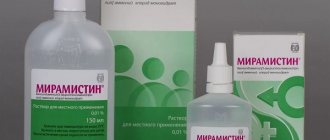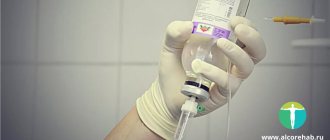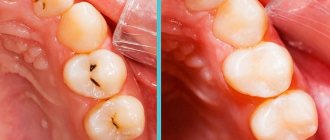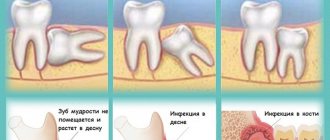Cold (ice pack, cold compress), elevated position of the affected limb and rest during the first day help relieve swelling after a bruise. Apply ointments with anti-edematous and anti-inflammatory effects - Heparin, Lyoton gel, Bruise Off, Troxevasin.
From the second day, physical therapy can be prescribed - magnetic therapy, UHF, then they are supplemented with electrophoresis, diadynamic therapy, ultrasound. For mild bruises, you can use folk remedies - salt, semi-alcohol compress, lotions with wormwood infusion.
In the absence of complications, swelling decreases significantly by the 3rd day, and completely disappears by the end of the week. If the condition worsens and pain and swelling increase, you need to be examined by a traumatologist. A mandatory visit to the emergency room is necessary in case of injury to the head, abdomen, back or chest; a dangerous sign is the inability to move a limb, weakness, or fainting.
Why does a blow cause swelling of the face?
The formation of swelling on the face usually occurs due to sudden bruising of facial tissues. This process is explained by the fact that at the impact site:
- The skin is injured.
- Small blood vessels are damaged.
- Liquid accumulates.
The time of swelling depends on the intensity of the blow to the face.
In this case, swelling occurs much earlier. Considering this factor, stagnation of blood may appear, which will look like a bruise.
Material and methods
A pilot prospective comparative study was conducted, which included 54 patients with soft tissue contusion of the shoulder (n=27) and hip (n=27). Bruises in all patients were characterized by the formation of subcutaneous or intradermal hemorrhage, swelling of soft tissues without muscle damage. Inclusion criteria
: age 25–50 years, compensated comorbid pathology.
Non-inclusion criteria
: decompensated concomitant pathology or requiring constant medical support; severe soft tissue damage; the injury is more than 1 day old; self-administration of analgesics and other medications for pain relief before the initial visit. All patients signed informed consent to participate in the study.
During the initial examination, all patients underwent an ultrasound examination of the injury site to exclude more severe pathology. Soft tissue swelling was assessed at each visit using the circumference of the injured limb segment, measured in the upper, middle, and lower thirds, and compared with the uninjured limb. Functional recovery was assessed by the patient's ability to flex the elbow and shoulder joint and squat at least 10 times, as well as hold a 2.5 kg load for more than 2 minutes in an outstretched arm.
Depending on the form of the drugs received, patients were divided into 8 groups. Group 1 (n=6) - patients with upper limb injuries who received ketoprofen tablets (Ketonal®) at a dosage of 100 mg once a day; Group 2 - patients with damage to the upper limb (n=6) who received diclofenac tablets at a daily dosage of 100 mg; Group 3 (n=7) - patients with damage to the lower extremity who received ketoprofen tablets at a dosage of 100 mg once a day; Group 4 (n=7) - patients with lower limb injuries who received diclofenac tablets at a dosage of 100 mg; Group 5 (n=7) - patients with injuries to the upper limb, for whose supervision they used the injection form of ketoprofen at a daily dosage of 100 mg; Group 6 (n=7) - patients with injuries to the upper limb, in whose treatment an injectable form of diclofenac 100 mg was used; Group 7 (n=7) - patients with injuries to the lower limb who received ketoprofen by injection at a dose of 100 mg; Group 8 (n=7) - patients with injuries to the lower limb and the use of an injectable form of diclofenac.
In all patients, in addition to analgesic therapy, on the 1st day the injury site was immobilized with a tight bandage and cooling procedures were applied. At the second visit (on the 2nd day and daily thereafter), the intensity of pain was assessed according to VAS, and the severity of edema. Treatment and monitoring of patients was stopped when a stable analgesic effect was achieved (according to VAS), there was no increase in soft tissue edema, and limb function was restored.
What to do immediately after an impact to avoid swelling of the face
To prevent swelling of the face, it is necessary to provide first aid in a timely manner. A few ice cubes may be needed. It is necessary to use something cold after the blow. When there is no ice, ice cream and even dumplings will do.
Cold objects will prevent blood and lymph from accumulating, since the cold will help slightly narrow the nearby vessels. This method only helps in the first 25 minutes.
When about half an hour has passed since the impact, you need to use the following methods:
- Herbal compress. Herbs (wormwood, calendula, St. John's wort and everyone's favorite in childhood, plantain) help best with swelling. Based on them, a decoction is prepared, which must be used cold.
- Black tea. It must be strong, then the tea will work. Application of a cotton pad soaked in tea to the face should be continued for at least 1 day.
- Onion juice. It helps if there are already bruises and swelling on the face.
- Table vinegar. 9% vinegar is best. Do not use this method if there are wounds on the skin.
- Homemade kefir. It can be replaced with fermented baked milk or homemade cottage cheese.
Using cold compresses
The use of cold is recommended for fresh injuries due to any cause. This reduces blood flow to the injured area, helping to reduce swelling and tissue damage that accompany inflammation.
Cold causes numbness, so use ice without medication to reduce pain while helping the affected area begin the healing process. Another added benefit of using ice is that it helps reduce muscle spasms. Ice packs are the most common way to apply cold, even a bag of frozen peas is enough to do the trick. Knowing when to use cold therapy is important for quick recovery from a recent injury or sudden onset of pain.
3 ways to supply cold:
Ice is good for many types of injuries. Here are 3 ways to apply ice:
Ice bag - small pieces of ice in a plastic bag. Hold for 10-20 minutes.
Reusable ice packs – often contain gel or chemicals. Always use a thin cloth barrier and keep on for up to 30 minutes.
Ice Massage – Rub pieces of ice over the painful area in a circular motion. Stop if your body goes numb.
How to quickly remove swelling from the face after a blow using store-bought products
If the swelling has not gone away 8 hours after the impact, then you need to use the remedies presented in the table below, which can be purchased at the pharmacy.
| Drug name | Action |
| Troxevasin. | Relieves facial puffiness and can also get rid of bags under the eyes. It has a fairly low price, which makes it more affordable. Also, this ointment removes the inflammatory process and accelerates the regeneration process. |
| Heparin ointment. | Relieves not only swelling, but also hematomas. Due to the active component ( heparin) , the ointment dissolves blood clots well. In addition, it is an excellent pain reliever. |
| "Venolife gel" | Contains heparin and dexpanthenol , which help restore the skin, relieve swelling and eliminate skin inflammation. |
In addition to the medications listed above, iodine mesh , which eliminates bleeding, will help remove swelling. An excellent alternative to such drugs can be Indovazin, Allantoin and Lyoton-gel.
Symptoms of bruise
It is not always possible to independently distinguish a bruise from a closed fracture. It is believed that with mild injury, the pain becomes less pronounced 2-3 hours after the injury. But in reality, it often happens that a fracture hardly bothers you, but a bruise causes a lot of unpleasant sensations even in the second and subsequent days.
Main symptoms of bruise:
- strong pain;
- internal or subcutaneous hemorrhage;
- edema;
- decreased mobility of the damaged area.
Bruising and swelling may appear immediately after injury or several hours later. Their severity depends on the depth of the lesion. The pain intensifies with pressure, and swelling sometimes increases for several days. Since the signs of a bruise and a fracture are similar, it is better to conduct an X-ray examination to ensure the integrity of the bones.
Top 2 most effective ways to relieve swelling on the face
In addition to expensive cosmetic procedures and pharmaceutical products, there are 2 cheap ways to eliminate this problem.
Method 1
- The first and most common method is to apply raw potatoes to the bruise site.
- Lotions based on coltsfoot decoction. The decoction can be easily prepared in 5-8 minutes. You just need to throw a tablespoon of the dry plant into boiling water (250 ml) and leave to boil for another 3 minutes.
Attention: the lotions must be cold, so the broth must be placed in the refrigerator.
Method 2
- Iodine network. She copes well with tumors.
- Applying cabbage. One of the budget methods that really works.
- Compresses. To create them, you need to boil the beans, which are then mixed with honey and 50 g of butter. Read more information on removing puffiness from the face and eyes here.
Heparin ointment
An effective remedy for bruises is heparin ointment. When using it, it is possible to remove the hematoma in the shortest possible time. The product is produced on the basis of petroleum jelly, which guarantees ease of application to the damaged area of the skin.
The active ingredient in the drug is sodium heparin. The substance belongs to the group of anticoagulants. It improves blood microcirculation in damaged tissues and promotes the resorption of hematomas. In addition, sodium heparin has anti-edematous and anti-inflammatory effects.
Other active ingredients in the ointment:
- Benzocaine. It belongs to the group of anesthetics and provides the product with analgesic properties.
- Benzyl nicotinate. This is an extract of nicotinic acid. The component improves the penetration of heparin deep into the skin.
Heparin ointment is recommended to be applied 2-4 times a day in a thin layer to the damaged area if there are no open wounds or scratches. Duration of treatment is up to 5 days. Heparin ointment is approved for use in children from 12 months.
Folk remedies for the treatment of swelling on the face
Unlike pharmaceutical products, traditional medicine cannot harm. Therefore, many people prefer folk remedies :
- Fresh potato juice . It is able to help regenerate the skin, and due to this effect it is found in many cosmetic products. To quickly get rid of swelling, you should grind one potato using a blender, and then apply compresses to the skin using gauze.
- Cheremsha. We only need the root of this plant. You need to prepare a decoction based on it. You can make compresses with it, which you need to keep for at least 20 minutes.
- Honey _ It is known for its anti-inflammatory properties, which is why many dermatologists recommend applying it to wounds. It perfectly nourishes and moisturizes the skin.
Objectives and types of drugs
Today, you can buy ointment for bruises with different pharmacological effects. But at the same time, all funds are aimed at solving the following problems:
- Dissolution of blood clots in the damaged area.
- Relieving swelling and inflammation.
- Reducing pain.
- Restoration of damaged tissues.
Ointments for bruises can be classified according to their effects as follows:
- Nonsteroidal anti-inflammatory drugs. When used, pain is reduced, swelling is relieved and inflammation is stopped.
- Decongestant and absorbable. With them, it is possible to slow down the development of edema and reduce pain by relaxing the smooth muscles of the blood vessels. In addition, the products help restore venous circulation.
- Cooling. They contain substances that irritate the nerve endings in the damaged area, resulting in a local analgesic effect. Also, such drugs increase blood flow and have anti-inflammatory properties. Against this background, metabolic processes intensify, which accelerates the restoration of damaged tissues.
Manufacturers also produce combination drugs that have the ability to have all of the above effects. This allows you to relieve pain and stop inflammation, which allows you to remove bruises in the shortest possible time.
How to relieve swelling of the eyes and lips
Sometimes, due to the blow, a bruise appears under the eyes , and the eye itself begins to seriously increase in size. Swelling of the eyes brings a lot of discomfort, and does not look very aesthetically pleasing.
In this case, after a blow, it is necessary to consult an ophthalmologist, because even a minor blow can lead to serious vision problems. It is very important that neither the lens nor the retina is damaged.
It is also strongly recommended to visit a doctor if even slight dizziness is noticed. When a person feels well, a visit to a specialist can be postponed and the swelling can be removed alone.
Punching your lip doesn't end with simple swelling. Due to the fact that the skin on the lip is very thin and delicate, the lip cracks. Capillaries that are located closely can also provoke skin rupture. If blood starts to flow from the blow, you must immediately disinfect the injury site.
Following disinfection, it is advisable to immediately apply something cold. The ideal option is ice wrapped in a bag. The skin of the lips after a rupture will need additional care. You must always remember that your lips need to be moisturized and nourished in a timely manner.
Bruised jaw. Consequences of injury and prevention
Go back Facial injuries are quite common. Even one careless movement can lead to a bruise or dislocation, which entails not only a painful condition, but also serious consequences, and also affects the aesthetic appearance. The most common injury is considered to be a bruised jaw. A jaw bruise is a disease that implies a mechanical injury that does not violate the integrity of the facial tissues and jaw bones. With a serious injury to the jaw, the bruise can spread to the upper and lower jaw. But, in 99% of cases, patients present with a bruise of the lower jaw. The treatment in both cases is identical. A bruise is the mildest injury, so seeking help in a timely manner will avoid unpleasant stages of the disease.
Causes
There may be several reasons that lead to a jaw bruise. The most common are: falls, as well as blows with a blunt object to the jaw area. Often such an injury can occur during a fight or an accident. How serious a bruise is can be determined based on the severity of the object during a fight or the force of the vehicle collision in an accident. A significant role is played by the elasticity of the skin and its damage before injury. After all, the healthier the bone tissue and skin on the face, the easier the bruise will be.
Symptoms
After a bruise occurs, the patient experiences the following symptoms:
- acute pain in the jaw area, which worsens during actions;
- redness of the facial skin, as well as damage in the form of scratches, abrasions and wounds;
- there is no opportunity to eat or talk;
- general deterioration of the body;
- fever and enlarged lymph nodes.
Treatment
It is quite simple to identify a jaw bruise, because it is practically no different from bruises of other parts of the body. Treatment is the same as for other bruises. The first step is to apply a bandage to the sore spot along with a cold compress of ice or cold water. Next, the jaw that has received a bruise must be provided with complete rest in order to avoid unpleasant consequences. There is no need to warm up the bruised area with heating pads or other warming agents in order to prevent inflammation from occurring. Diagnosis of a bruise can be imaginary, since behind the bruise you may not notice a dislocation or, even worse, a fracture of the jaw. Therefore, immediately after providing first aid, you should immediately go to the hospital to establish an accurate diagnosis and further treatment. An accurate diagnosis can be easily established at a medical center using an X-ray image.
Consequences and prevention
Untimely treatment of the disease or neglect of medicine can lead to very serious consequences, such as jaw deformation - periostitis. Also, untimely treatment can provoke restriction of jaw movement: the inability to fully chew or yawn. By seeking help from a doctor immediately, the disease can be treated quickly and favorably. Paying attention to your actions will help you avoid such an unpleasant injury as a bruise.
For consultations at the KIITOS dental clinic, please contact the administrators.
What not to do when treating swelling after a stroke
If a small tumor or swelling appears, you must immediately find out what is strictly undesirable to do so as not to aggravate the situation. Since some points can complicate the process of skin regeneration, it is necessary to eliminate all risk factors:
- Alcohol. It has the property of retaining excess water in the body. Therefore, in order to eliminate the risk of new edema, it is necessary to completely abstain from alcoholic beverages until complete recovery.
- Sanya, bathhouse, as well as all procedures that are carried out along with elevated temperature. Heat can cause swelling to become even worse. It is also not recommended to visit the solarium.
- Swelling massage . Any massage actions with swelling are strictly prohibited, since capillaries and muscle tissue are damaged at the site of impact. This can cause bleeding, causing a bruise to appear in this area.
Let's get rid of hematoma and pain
If after a bruise a bruise on the face or a hematoma with swelling appears, then they usually do not require a visit to the doctor; you can treat and relieve the symptoms yourself. Only a large hematoma requires examination by a specialist; sometimes it is necessary to perform a puncture to remove accumulated blood. After local anesthesia, the wound is opened by a surgeon, then a tight bandage needs to be made. The operation may be performed several times to get rid of the hematoma until the bleeding stops.
To treat a hematoma on the face faster and to avoid pain and swelling, use an anti-inflammatory ointment, cream or gel, for example:
- fastum gel;
- dolobene;
- indovazine;
- long;
- ketonal;
- quickgel
To eliminate pain, you can take an analgesic in the form of tablets (citramon, pentalgin, solpadeine).
What complications can there be?
When first aid was not provided on time, after the blow some complications may remain, which will be extremely difficult to get rid of:
- If you hit the nose, blood clots may remain in that place, which look like small seals . They often become inflamed, causing a person to develop a fever. In this case, you should immediately visit a doctor, given that the injured skin may become infected.
- When the seals do not resolve, then there is a risk of a cancerous tumor . To prevent this, it is necessary to use both pharmacy and folk remedies.
- Sometimes swelling can signal a fracture . An x-ray should be taken just in case.
Results and discussion
The average age of the patients was 44.7 years. The ratio of men to women was 1:1.
As can be seen in Figure 1, with bruises of the upper limb, ketoprofen tablets began to show its activity already at the 10th minute, with bruises of the lower limb - somewhat later, at the 20th minute. The use of the injection form (Fig. 2) provided a pronounced analgesic effect already at the 5th minute. Both tablet and injection forms of ketoprofen demonstrated an advantage over diclofenac. By 3–4 days, in all cases it was possible to achieve complete pain relief. The duration of the analgesic effect of the drugs was not studied due to the large psycho-emotional component and the small sample of patients. A peculiarity of the assessment of pain syndrome at the initial visit was that patients with a shoulder injury rated pain 2–3 points higher than patients with a hip injury (6–8 points).
I would like to note that, despite the effectiveness of the injection form of the drug, the tablet form remained the form of choice for patients with arm injuries, according to the survey. In patients with leg injuries, the injection form was preferred. Here we have to state a paradox: with a more severe pain syndrome due to a bruise of the upper limb, a more effective injection form is used much less frequently than in patients with damage to the lower limb.
Stages of healing: how many days does it take for swelling to go away?
This chronology shows how long it takes for a black eye to go away without the use of medications, that is, in its natural form of manifestation immediately after the blow:
- from 10 minutes to an hour - skin color ranging from light pink to burgundy;
- the first 6 hours - the blood, coagulating, changes the shade of the soft tissues to purple or blue;
- on the second day - a brown-green border appears along the edges;
- 5-6 days - the staining area decreases, this is accompanied by a change in color: the center remains red-blue, the middle acquires a greenish or brown tint, and the bruise ends in yellow;
- week - the black eye becomes significantly smaller;
- 10-14 days - a slight yellow mark remains at the site of injury, but if the degree of injury was minor, then the skin will already be restored to normal within this period.
Return to contents
Possible consequences
The most common negative consequence of suffering a severe bruise in the eye area is hemosiderin pigment spots. A cosmetologist will treat the problem, but if the problem is long-standing, perhaps a surgeon.
There is also a risk of damage to the visual apparatus. Let's consider the frequent consequences of facial bruises in order of harm to health (from mild to severe consequences):
- Hyphema is an accumulation of blood clots in the anterior part of the eye organ, which resolves a few days after damage in the absence of other harmful factors;
- Orbital contusion is a temporary or lifelong condition in which visual acuity is lost and there is a risk of strabismus;
- Retinal detachment - occurs due to excessive hemorrhage upon impact. Treatment of the disease takes years and is quite expensive;
- Hemophthalmos - blood enters the vitreous body, which is fraught with serious disruptions to the functioning of the organ and can lead to complete blindness.
Return to contents
Correctly treating children's injuries
Children are often injured due to high activity. Roller skating, cycling and swinging, even simple outdoor games are accompanied by falls and, as a result, injuries, sprains, hematomas and abrasions. To provide first aid for a bruise, it is advisable to keep several proven means and dressings in your first aid kit.
Minor injuries bother you for a few minutes, and then the child continues to actively have fun. To ensure that infection in an abrasion on a bruised knee or elbow does not cause inflammation, proper treatment is required. A special self-fixing bandage will protect the damage from additional mechanical impact and penetration of pathogens.
If the injury is accompanied by an abrasion, an antibacterial sterile adhesive bandage or a bright patch with pictures will do. The central section of the bandage and plaster is impregnated with special compounds that promote rapid healing and absorption of oozing fluid from the wound surface.
For very painful bruises, first aid is provided with a hydrocolloid patch. It will relieve pain and promote wound healing by creating an optimal environment. The material absorbs discharge from a bruised wound and protects against infections. After dressing, you can go to a medical facility.
Products based on comfrey and badyagi
Preparations based on hematomas based on comfrey root and freshwater sponge badyagi have good resorption properties. Such products are presented by manufacturers in a huge variety. You can buy them at the pharmacy at an affordable price.
The effectiveness of comfrey root, which is also known as larkspur, against bruises has long been known. The plant was dried and crushed, and after that infusions were prepared, which were applied to bruises in the form of compresses. Ointments, gels and balms based on larkspur are presented in pharmacies in a wide range of multi-component formulations. Any remedy for bruises can quickly reduce swelling. The drugs have an analgesic effect and promote tissue restoration. Their peculiarity is the absence of contraindications.
The skeleton of the freshwater sponge badyaga consists of silicon oxide. The product is crushed and a powder is obtained, consisting of microscopic needles of silicon oxide. It is the basis of an ointment, which, when applied to damaged skin, has a local irritating effect. This allows you to increase blood circulation and speed up the processes of healing and tissue regeneration. When using it, it is important to exclude individual intolerance to the active substance.
Mani based on comfrey and badyagi is applied to damaged areas 3-4 times a day. It is not recommended to use the products during pregnancy and lactation, as well as before reaching the age of 12 years.











